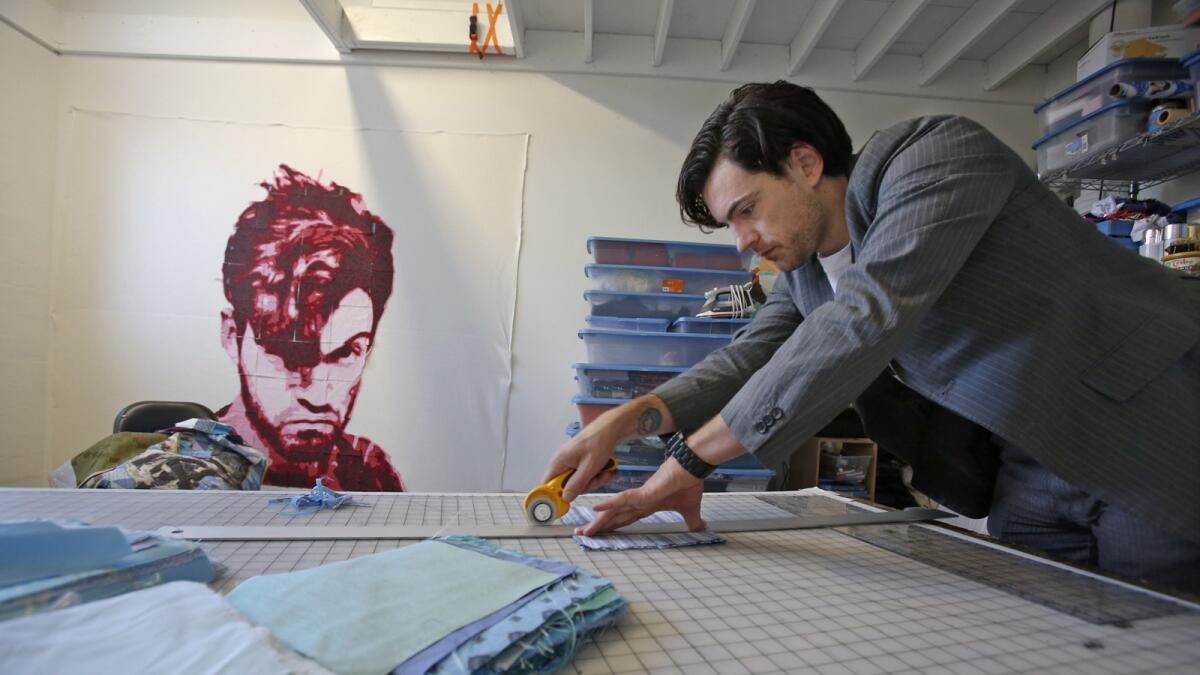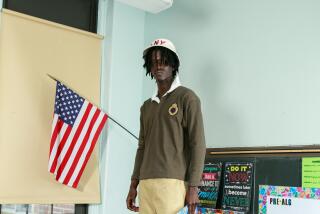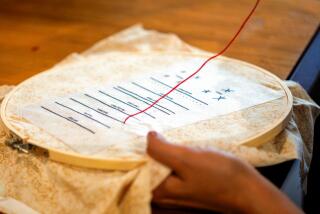Male quilters piece new gender, aesthetic paradigms in ‘Man-Made’ show

“How would a guy make a quilt?” Joel Otterson asked himself when he began his foray into the craft.
“He would make it out of concrete and stone,” he answered. And so he did.
Otterson’s “quilts” consist of interlinking blocks of concrete, stone and ceramics that are meant to be walked and danced on rather than slept under. One is 19 by 22 feet and made from six tons of concrete and 500 dinner plates cut into 4,000 pieces. There’s even a “crazy quilt” made from the scraps of his concrete projects.
Otterson is one of eight artists involved in “Man-Made: Contemporary Male Quilters,” opening Jan. 25 at the Craft & Folk Art Museum in Los Angeles and curated by CAFAM Executive Director Suzanne Isken. Cluttered with heavy metal iconography and images of guns, basketballs, caustic political commentary and the occasional expertly executed log cabin pattern, the “Man-Made” quilts prove that testosterone and needlework aren’t mutually exclusive.
Men have been quilting since the dawn of the 19th century, but these artists express a fresh and irreverent sense of masculinity and in some cases sexuality through mismatched patches of fabric like never before. For them, quilting is not an attention-grabbing shtick. Isken says the pieces on display fall in the category of fine art based on their technical acumen and their ability to push aesthetic boundaries and upend accepted themes of the traditional medium.
The art quilts of “Man-Made” seek to sweep gender paradigms into history’s dustbin, showing how the modern men joining the global sewing circle add a boisterous voice of virility to a traditionally soft conversation, with interesting wrinkles.
In addition to his work with concrete, Otterson sews fabric quilts.
“I put a big naked cowboy in the middle of it, just because I could,” he says, giggling over a quilt in his colorful downtown L.A. studio. “When in doubt, put some nudity in it, I always say.”
He calls it his queer aesthetic. Moreover, he says, if women can become CEOs of major corporations, he can sit at home and sew.
“I’m a big, burly guy, and I’m making quilts,” he says.
Cluttering nearly every surface of his light-filled space overlooking the damp concrete cavity of the L.A. River: beads, a riot of fabric, a kiln, a vintage black May’d Best sewing machine on a wooden table with a knee pedal and piles of books, including a worn copy of “Woman’s Day Book of American Needlework.”
Otterson, 55, says in his “old age” he has come to prefer needlework. He thinks of it as his own brand of feminism. Or is it feminist-lite?
The question of gender and gender identity is a source of debate when it comes to male quilters, curator Isken says. It began when Michael James, a leader of the art-quilt movement that blossomed in the 1970s, wrote to the editor of Quilters Newsletter magazine, suggesting the need for a new form of quilting, one that dismantled tradition. Dozens of female readers immediately criticized him, saying his ideas would likely strip the craft of its female and community-driven identity.
“But it turned out that a lot of male quilters had tried to address their maleness and otherness in the quilt world, and it was really interesting,” says Isken, adding that the work in “Man-Made” is particularly noteworthy for its reflection of contemporary urban life. The unconventional quilts are in no way, their creators stress, intended to make fun of or reduce the importance of women practicing the art.
Isken said she was nervous about staging the show at first, because CAFAM is known for championing the work of women, but that feeling lessened as she got to know the work of the men in the show.
“We’re not showing this because we think one is better,” she says. “We’re showing one moment and one idea. There’s a place for that amazing [feminist] history and also a place for this.”
For his part, Luke Haynes, who wields an industrial long-arm sewing machine like a chain saw on the second floor of his L.A. loft, says there is no gender bias in his quiltmaking. Home economics isn’t just for girls anymore, just like shop isn’t only for boys. Plus, rabid consumer culture has made the idea of buying a blanket more attractive and much easier than making one, so mothers and grandmothers don’t generally pass down the art form to their daughters the way they once did.
“Because there was a break in tradition, we’ve seen a huge jump in male quilters. It’s not moms to daughters, it’s YouTube to whoever is interested,” he says, sitting in a cat-scratched yellow chair beside a TV flickering with an image of burning logs. “It’s classes to anyone who likes material, it’s fiber arts school to any student who shows up.”
Haynes is straight, but the Brooklyn Museum once referred to him as gay on a placard featuring one of his quilts — which tickled him.
“I love this projection of ideas on object and material and medium,” he says. “Plus, how fun is it to come out as a straight, white man?”
Haynes was one of those kids who couldn’t stop moving, so his parents found a way to deal with his busy hands: They started him knitting. From then on he was obsessed with functional art. That ultimately led to a career in architecture, which he left to become a full-time quilter. He specializes in quilts with images of himself stitched into them. He thinks of it as creating a brand: the Luke Haynes.
Haynes likes to work with recycled fabric and used clothes, as does San Francisco artist Ben Venom. Working out of his Mission District studio, Venom is known for quilts made of heavy metal T-shirts.
“I fully recognize that what I do is a little bit absurd,” Venom says, noting the thrill that comes from an idea which on a scale of 1 to 10 is “so absurd or ridiculous that you’re pushing past 10.”
He points to the public’s fascination with NASCAR and monster trucks as an example. The former is just cars driving in circles, Venom says, but the nonsensical qualities are precisely what make it attractive to some.
Venom’s friends and family donate their old clothes to him for use in quilts.
“You can see a piece of the community at large. Rips and tears are there for everyone to look at,” he says. “It’s a large woven history of personal memories.”
For most of the quilters in “Man-Made,” no connection is more personal than the one they shared with their mother or stepmother. In the case of Shawn Quinlan, a TV news video editor from Pittsburgh, his first sewing machine came from his stepmom.
Quinlan makes wild, acerbic quilts with themes of war, greed, terrorism and political hypocrisy. To perfect his craft, he watched a lot of quilting shows on TV. He then received a warm welcome into quilters’ ranks in real life. He joined a quilt guild, and when the guild women saw his work, they directed him to contemporary quilt shows that encouraged him to shoot for bigger venues.
One of Quinlan’s quilts employs a pair of basketballs, a double cheeseburger and some missiles in service of what appears to be a giant abstract phallus.
“I’m pretty gay,” Quinlan jokes. “So I sometimes don’t know how masculine my work is.”
-----------------------------------
‘Man-Made: Contemporary Male Quilters’
What: The work of artists Joe Cunningham, Luke Haynes, Jimmy McBride, Aaron McIntosh, Dan Olfe, Joel Otterson, Shawn Quinlan and Ben Venom
Where: Craft and Folk Art Museum, 5814 Wilshire Blvd., Los Angeles
When: Jan. 25 to May 3
Admission: $5 to $7
Info: (323) 937-4230, https://www.cafam.org
More to Read
The biggest entertainment stories
Get our big stories about Hollywood, film, television, music, arts, culture and more right in your inbox as soon as they publish.
You may occasionally receive promotional content from the Los Angeles Times.











